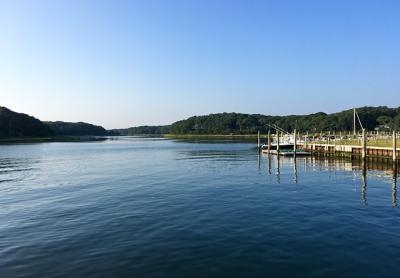Hog Creek to Be Studied

The Town of East Hampton’s Natural Resources Department is overseeing a study of Hog Creek in Springs aimed at assessing nitrogen loading and identifying hot spots of nitrogen-rich groundwater intrusion so that mitigation measures can be implemented, the East Hampton Town Trustees were told on Monday.
Kim Shaw, the department’s director, and Mellissa Winslow, an environmental analyst, told the trustees that Roux Associates of Islandia was awarded a contract to conduct a groundwater seepage monitoring study, at present underway and funded by the community preservation fund, a percentage of which can be allocated to water quality improvement.
The first step, Ms. Winslow told the trustees, is an input evaluation to determine a baseline of the nitrogen load in the water body and the nitrogen concentration in the groundwater discharge entering its surface waters. To that end, Roux Associates is installing monitoring wells, both upland in road rights of way and at Hog Creek’s perimeter, and taking surface water samples. “There’s upland, shoreline, and surface water samples being taken,” she said. “The results will be used to determine . . . hot spots we should be focusing on for remediation.”
As with a similar study at Pussy’s Pond in Springs, Ms. Shaw said, “This gives you a better picture of, ‘Are the septic systems at residential homes failing, are they contributing to groundwater contamination?’ ” The Natural Resources Department, she said, is overseeing a rebate program under which property owners are encouraged to install new, nitrogen-reducing septic systems, and participation is high among homeowners around Hog creek. “We’re finding out they had bad connections, they had no connections to [leaching] pools, their pipes had rotted away. It’s going to be interesting to see what kind of information comes out of this, but this neighborhood has been very active in participating in the rebate program. We are hoping this encourages other people.”
Roux Associates is targeting Hog Creek now, Ms. Winslow said, “when we would expect the highest nitrogen concentrations coming from septic systems because all the seasonal homeowners are going to be around. . . . Based on those results, they may propose doing two or three more rounds” in order to have a fuller understanding of nitrogen loading.
Should hot spots of groundwater intrusion be identified, permeable reactive barriers could be designed and installed as a passive remediation effort, she said, but “the long-term goal is to upgrade the septic systems and get rid of the source of the nitrogen.” The project is a potential pilot program for other water bodies, such as Lake Montauk or Three Mile Harbor, she said.
Also at the meeting, John Aldred told his colleagues that the just-concluded mosquito larval sampling pilot program at Accabonac Harbor, conducted jointly by the trustees, the Nature Conservancy, and the Suffolk County Department of Public Works’ vector control division resulted in reduced and more targeted application of methoprene, a larvicide.
Methoprene’s use is controversial on the South Fork. Environmentalists, scientists, and many elected officials argue that it is harmful to nontarget species, including lobsters, crabs, and fish, and some neighboring states and municipalities have restricted its use.
Partly because of dry conditions, Mr. Aldred said, very few larvae were found in sampled areas until the middle of last month. Based on the samples, the vector control division did not apply methoprene via helicopter, as it has routinely done for several years. When spraying did occur, “it was initially determined that they could do it with Bti,” a biological agent that is believed to be harmless to nontarget species.
The presence of larvae, which Mr. Aldred said were found in the same places in each weekly sample, “started to pick up on the 16th” of July. “Once into August, we were starting to see a lot more larvae, but basically in the same places.” In addition to determining whether or not methoprene application could be avoided, vector control was “able to target the areas that produce the larvae, as opposed to having to do blanket spraying,” he said. “That was the case throughout the season.”
Larvae were generally found where marsh meets upland, Mr. Aldred said, “where there might be holes or little depressions that would collect water. If the tide is able to flush an area, it will generally not produce larvae.” Further study could result in efforts to grade or drain those hot spots to become less hospitable to mosquito breeding. “That may be something we will be able to work on through the winter and into next season with vector control and the Nature Conservancy,” he said.
The trustees also voted on Monday to retain the services of Daniel Spitzer of Hodgson Russ L.L.P. to represent them in negotiations with Deepwater Wind, which proposes to land a transmission cable from the offshore wind farm it hopes to construct approximately 30 miles from Montauk at the ocean beach at the end of Beach Lane in Wainscott. Mr. Spitzer will be tasked with guiding the trustees in negotiating a land-use agreement with Deepwater Wind as well as their participation as interveners in a review process under the state public service law, known as Article VII, covering applications to construct and operate a major electric transmission facility.
